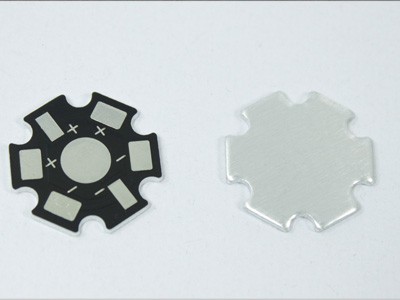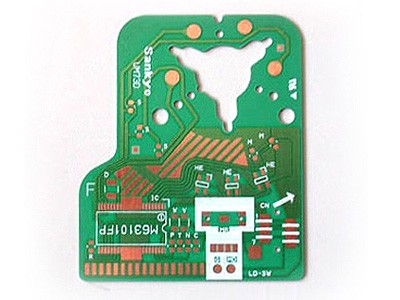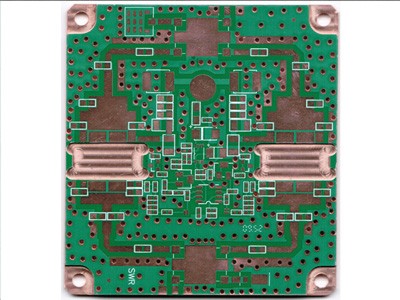
A Metal Core PCB, often abbreviated as MC PCB, is a type of printed circuit board that uses a metal core as its base material instead of the traditional fiberglass (FR-4) or other dielectric materials. The metal core provides improved thermal conductivity, making these PCBs suitable for applications that require efficient heat dissipation.
Key characteristics of Metal Core PCBs (MC PCBs) include:
Metal Core: The core of these PCBs is typically made of materials like aluminum (Al), copper (Cu), or steel, which have high thermal conductivity properties. Copper is particularly popular due to its excellent thermal performance.
Thermal Management: MC PCBs are often used in applications where heat generation is a concern, such as high-power LED lighting, power electronics, and automotive components. The metal core helps dissipate heat away from heat-generating components.
Dielectric Layer: The metal core is typically sandwiched between layers of dielectric material that electrically insulate the conductive traces from the metal core. The dielectric material is chosen based on electrical and thermal insulation requirements.
Circuit Traces: Like traditional PCBs, MC PCBs have circuit traces, components, and solder mask layers on top of the dielectric material. These traces allow for the connection of electronic components.
Applications: MC PCBs are commonly used in applications where maintaining lower operating temperatures and preventing overheating is crucial for device performance and reliability.
LED Lighting: MC PCBs are widely used in LED lighting products, especially those with high power or high brightness requirements, to effectively dissipate the heat generated by the LEDs.
Power Electronics: They are used in power supply units, motor control systems, and other power electronics applications where efficient heat dissipation is essential.
When dealing with MC PCBs, it's essential to select the appropriate metal core material, dielectric material, and thermal design to meet the specific requirements of your application. The choice of materials and design will impact the overall performance, reliability, and cost of the PCB.
Metal Core PCBs (MC PCBs) come in various types and configurations, each designed for specific applications and performance requirements. The choice of MC PCB type depends on factors like thermal management needs, electrical characteristics, and overall application requirements. Here are some common types of MC PCBs:
Aluminum MC PCBs: These are MC PCBs with an aluminum core. Aluminum has good thermal conductivity and is often used in applications where effective heat dissipation is critical. Aluminum MC PCBs are commonly found in LED lighting, power supplies, and automotive electronics.
Copper MC PCBs: Copper MC PCBs have a copper core, which offers even higher thermal conductivity compared to aluminum. They are ideal for applications with extremely high heat dissipation requirements, such as high-power LED lighting, power amplifiers, and RF electronics.
Steel MC PCBs: Steel MC PCBs use a steel core, which provides good thermal conductivity and high mechanical strength. These PCBs are suitable for applications where both thermal performance and mechanical durability are important.
Hybrid MC PCBs: Hybrid MC PCBs combine multiple core materials, such as a combination of aluminum and copper layers. These boards are designed to offer a balance between cost, thermal performance, and specific application needs.
Single-Layer MC PCBs: These are MC PCBs with a single layer of circuit traces on one side of the metal core. They are often used in simple applications where thermal management is the primary concern.
Double-Layer MC PCBs: Double-layer MC PCBs have circuit traces on both sides of the metal core. They are more versatile and can be used in a wider range of applications, including those requiring complex circuitry.
Multi-Layer MC PCBs: Multi-layer MC PCBs consist of multiple layers of dielectric material with circuit traces sandwiched between them and a metal core at the center. They are suitable for applications requiring high-density interconnects and complex circuits.
High-Frequency MC PCBs: These MC PCBs are designed for high-frequency applications, such as RF (radio frequency) and microwave electronics. They are engineered to maintain signal integrity and minimize signal loss.
Thermal-Insulated MC PCBs: In some cases, MC PCBs may include thermal insulation layers to direct heat flow away from sensitive components or to prevent electrical interference between layers.
Flexible MC PCBs: Flexible MC PCBs combine the benefits of MC PCBs with flexibility. They are used in applications where the PCB needs to conform to a curved or irregular shape while still providing thermal management.
Ceramic-Based MC PCBs: These MC PCBs use a ceramic core, which provides excellent thermal performance and electrical insulation. They are suitable for applications with stringent thermal and electrical requirements.
When choosing an MC PCB type, it's essential to consider the specific needs of your application, including thermal management, electrical performance, and mechanical requirements. Working closely with a PCB manufacturer with expertise in MC PCBs can help you select the right type and design for your project.
 Aluminium Core PCB
Aluminium Core PCB
When choosing an Aluminium Core PCB (Printed Circuit Board) manufacturer, making informed decisions is crucial, as it directly impacts the success of your electronic product. In this process, here are some key steps to help you select the most suitable manufacturer to meet your needs and standards. Understanding Your PCB Requirements Defining Your Project’s Specific…
 Iron Core PCB
Iron Core PCB
Iron Core PCBs, also known as Iron-Core Printed Circuit Boards, are a type of printed circuit board that incorporates iron core materials into their construction. These PCBs are designed to have specific electromagnetic properties, making them suitable for applications where magnetic fields need to be controlled or manipulated. Here are some key points to understand…
 Copper Core PCB
Copper Core PCB
what is a Copper Core PCB? A Copper Core PCB, also known as a Copper Core Printed Circuit Board or Copper Substrate PCB, is a type of printed circuit board designed with a central core layer made primarily of copper. Unlike traditional PCBs where the core is typically made of non-conductive materials like FR-4 (a…
The production of Metal Core PCBs (MC PCBs) can pose some challenges and difficulties compared to standard FR-4 PCBs due to the specialized materials and construction involved. Here are some of the production difficulties associated with MC PCBs:
Material Selection: Choosing the right core material for MC PCBs is critical. The core material, often made of metals like aluminum or copper, should have the appropriate thermal conductivity for the application. Different applications may require different core materials, and selecting the wrong one can lead to inefficiencies in heat dissipation.
Thermal Compatibility: Ensuring that the various materials used in the MC PCB (metal core, dielectric layers, copper traces) have compatible coefficients of thermal expansion (CTE) is crucial. Mismatched CTEs can result in delamination or mechanical stress during thermal cycling.
Thermal Lamination: Bonding the core material to the dielectric layers can be challenging, especially when using materials with different properties. The lamination process must be carefully controlled to avoid defects or separation between layers.
Copper Cladding: Applying copper cladding to the metal core presents unique challenges. Adhering copper to metals like aluminum or copper requires specific surface treatments and adhesion techniques to ensure a strong bond.
Copper Plating: Electroplating copper onto the PCB surface for creating circuit traces can be more challenging on MC PCBs due to the metal core. Proper surface preparation and plating techniques are critical to ensure uniform copper thickness and adhesion.
Drilling and Machining: MC PCBs may require specialized drilling and machining techniques, especially when creating holes for vias or cutouts in the metal core. Precision is essential to avoid damage to the core material.
Heat Distribution: Ensuring even heat distribution across the PCB is vital for effective heat dissipation. The design and placement of thermal vias, pads, and components require careful consideration to achieve this.
Quality Control: Thorough quality control measures are necessary to detect defects like delamination, voids, or uneven copper distribution. Inspecting MC PCBs for these issues can be more challenging than with standard PCBs.
Testing: Testing MC PCBs for thermal performance and electrical integrity often involves specialized equipment and methods. Thermal cycling tests are essential to verify the board's ability to handle temperature variations.
Handling and Assembly: MC PCBs are typically heavier and less flexible than standard PCBs, making them more challenging to handle during assembly. Specialized handling and assembly equipment may be required.
Cost: MC PCBs tend to be more expensive to produce than standard PCBs due to the cost of metal core materials and the additional processing steps involved.
Overcoming these difficulties in MC PCB production requires expertise in materials science, PCB manufacturing, and thermal management. Collaborating with experienced PCB manufacturers who specialize in MC PCBs can help ensure that these challenges are effectively addressed and that the final product meets the required performance and reliability standards.
Choosing the right Metal Core PCB (MC PCB) factory is a crucial step in ensuring the quality and performance of your MC PCBs. Here are steps to help you choose the right MC PCB factory:
Define Your Requirements:
Clearly specify your MC PCB requirements, including material type (e.g., aluminum, copper), thickness, thermal conductivity, dielectric material, copper weight, and any specific technical requirements like impedance control or thermal management needs.
Research Potential Suppliers:
Conduct online research and create a list of potential MC PCB manufacturers. You can use search engines, industry directories, trade shows, and recommendations from colleagues to find candidates.
Assess Experience and Reputation:
Check the experience and reputation of each potential factory. Look for companies with a track record of producing high-quality MC PCBs. Check for customer reviews and testimonials.
Quality Assurance and Certifications:
Ensure that the MC PCB factory adheres to international quality standards such as ISO 9001. Check for relevant certifications and industry-specific standards, especially if your application has specific requirements.
Material Expertise:
Evaluate the factory's expertise in working with the specific MC PCB core material you need (e.g., aluminum or copper). They should have experience in handling and processing the chosen material.
Technical Support:
Inquire about the factory's ability to provide technical support. They should be able to assist with thermal design considerations, impedance matching, and other technical aspects related to MC PCBs.
Samples and Prototyping:
Request samples or prototypes to assess the quality, workmanship, and performance of the MC PCBs produced by the factory. This allows you to verify their capabilities.
Lead Times and Production Capacity:
Determine the factory's lead times for production and delivery. Make sure they can accommodate your project's timeline. Check if they have the production capacity to handle your order size.
Cost and Pricing:
Obtain detailed quotes from multiple MC PCB factories to compare pricing. Be cautious of significantly lower prices, as they may indicate subpar quality. Consider the overall cost, including shipping and any additional fees.
Communication and Responsiveness:
Gauge the factory's communication skills and responsiveness. Timely and clear communication is essential, especially when issues, changes, or clarifications arise.
Geographical Considerations:
Assess the factory's location and proximity to your facility. This can impact shipping costs, lead times, and communication ease.
Environmental Practices:
Inquire about the factory's environmental practices and their commitment to sustainability. Sustainability considerations are increasingly important in manufacturing.
Visit the Facility:
If feasible, visit the MC PCB factory's manufacturing facility to inspect their equipment, quality control processes, and overall capabilities.
Contracts and Agreements:
Carefully review all contracts and agreements to ensure they cover important aspects such as quality standards, material sourcing, intellectual property protection, and dispute resolution.
Feedback and References:
Request references from the factory and contact these references to gather feedback on their experiences with the MC PCB factory.
Choosing the right MC PCB factory requires thorough research and due diligence. Quality, reliability, and the factory's expertise in working with metal core materials are of utmost importance to ensure the success of your MC PCB project.
Welcome to buy MCPCB from metal core PCB manufacturer at very competitive factory price.